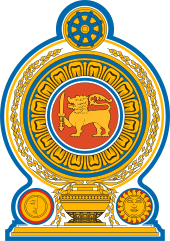Clerk of Parliament
|
Parliament of the Democratic Socialist Republic of Sri Lanka ශ්රී ලංකා පාර්ලිමේන්තුව இலங்கை பாராளுமன்றம் |
|
|---|---|
| 15th Sri Lankan Parliament | |
 |
|
| Type | |
| Type | |
| Leadership | |
|
Dhammika Dasanayake
Since 18 August 2015 |
|
| Structure | |
| Seats | 225 |
 |
|
|
Political groups
|
Government (156) Opposition (69) |
|
Length of term
|
5 years |
| Elections | |
| Proportional representation | |
|
Last election
|
17 August 2015 |
|
Next election
|
On or before 17 August 2020 |
| Meeting place | |
 |
|
| Parliament Building, Sri Jayawardenepura Kotte | |
| Website | |
| www |
|
Government (156)
Opposition (69)
The Parliament of the Democratic Socialist Republic of Sri Lanka (Sinhala: ශ්රී ලංකා පාර්ලිමේන්තුව Shri Lanka Parlimenthuwa) is the supreme legislative body Sri Lanka. It alone possesses legislative supremacy and thereby ultimate power over all other political bodies in the island. It is modeled after the British Parliament.
It consists of two hundred and twenty-five (225) members known as Members of Parliament (MPs). Members are elected by proportional representation for five-year terms, with universal suffrage. Parliament reserves the power to make all laws.
The President of Sri Lanka has the power to summon, suspend, prorogue, or terminate a legislative session and to dissolve the Parliament. The Speaker or, in his absence the Deputy Speaker and Chairman of Committees or the Deputy Chairman of Committees, presides over Parliament.
Parliament has the power to make laws, including laws having retrospective effect and repealing or amending any provision of the Constitution, or adding any provision to the Constitution.
The first legislature established in Ceylon was the Executive Council and the Legislative Council, which were established on March 13, 1833 according to the recommendations of the Colebrook-Cameron commission. The Executive Council was composed of the Colonial Secretary, the officer commanding the Military Forces, the Attorney General, the Auditor-General and the Treasurer and the duties of the council were advisory and the Governor of Ceylon, who presided over their meetings and consulted them but was at liberty to disregard their advice. At first it was made up of only British officials but later included native citizens. At the beginning 16, and later 49, members were elected for the Legislative Council, but a limited number of people were qualified to vote.
...
Wikipedia
